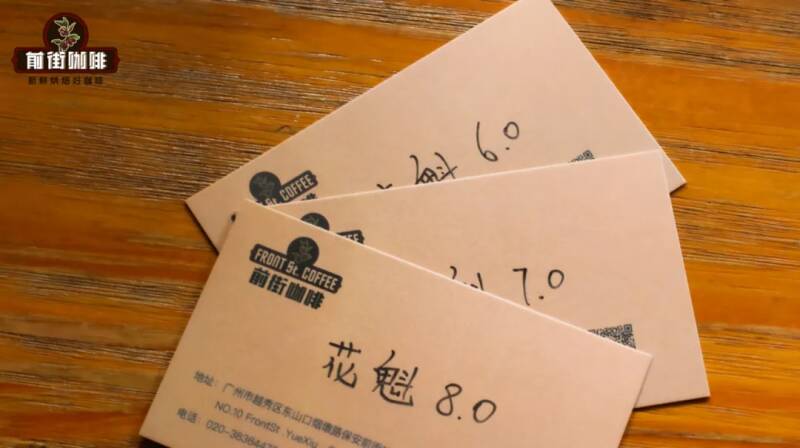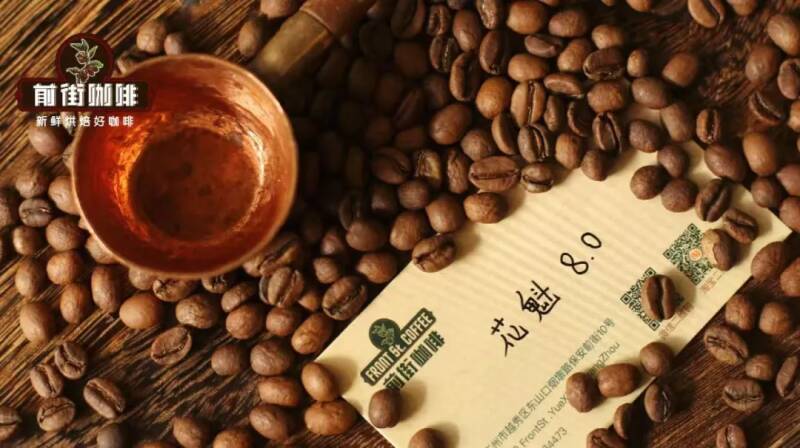When will Huakui 9.0 be available? What does Hua Kui X mean? What is Huakui Coffee?
This year is the ninth year after "Huakui Coffee" became popular. If the previous naming rules are followed, the Huakui Coffee listed this year should have a suffix of "9.0". But more than half a year has passed since then, and many friends have found that they hardly see "Flower Kui 9.0" on the menu of offline coffee shops! Not only that, even Qianjie, who should have issued the review early, did not share tweets related to 9.0. This can't help but make people curious. Isn't there a "Flower Kui 9.0" this year?

Yes and no. The new season's flower queens have actually been on the market, and the latest batch of flower queens are already on the shelves on the street. If we follow the naming rules we have understood in the past, it should indeed be called Huakui 9.0. But unfortunately, this set of rules is somewhat different from what we understand, so this year's Huakui is not called Huakui 9.0. This does not prevent it from still being a flower queen, so today Qianjie will come to share with you why there is no flower queen 9.0 this year, and whether it has the same "flower queen flavor" as usual.
Why is this coffee called "Flower Kui"? Before "Huakui Coffee" became "Huakui", its name was "Hambella", which translates to "Hambella." Like most coffees, it is named after the area where the coffee is produced. Hambera is a sub-production area of the Guji production area in Ethiopia, that is to say, Huakui production from Guji Hambera. If you want to trace the origin in more detail, it is a sun-cured G1 coffee produced by the Buku Abel processing plant in Dimtu Town, Hambera region.
In February 2017, Ethiopia's DW Coffee Company chose this sun-dried coffee bean from the Buku Abel processing plant in Hambella to participate in the raw bean competition TOH (Ethiopia National Taste of Harvest competition) organized by the African Fine Coffee Association. Then this coffee bean won the championship with its extremely strong berry aroma and creamy texture.
Later, the coffee bean that won the crown was bought by a raw bean trader in Beijing. Based on its flavor and performance, the raw bean trader gave it the name "Flower Kui", which means "the leader of all flowers, the beauty of the group." So from here, everyone can know that "Huakui" is neither a variety name nor a place of origin, but a product name. After being introduced into China, Huaqui was used as a competition bean by a contestant in the China Coffee Brewing Competition. In the end, they also achieved second place thanks to their excellent aroma and outstanding performance by the contestants. However, since most of the players below their rankings chose Rose Summer as the competition bean, in addition to the second place, Flower Kui was also focused on "beating all Rose Summer" and successfully became the "popular flower" for 17 years."
You know, the advantage of Huaquai is not only its good flavor, but also its price is very friendly to the people. So when everyone really started to contact Hua Kui offline, they were immediately captured by Hua Kui's extremely high cost performance. With the emergence of the phenomenon of human-to-human transmission, Hua Kui's reputation has also increased. The explosion of Huaquai has increased the market demand for it. It is reported that DW Company produced tens of millions of tons of Huaquai back then. Obviously, such a large output is not something that previous productivity can solve. Therefore, after Hua Kui became famous, DW Company gradually expanded its productivity as demand increased. In addition to the Buku Abel we mentioned at the beginning, four small villages around it, including Buku Saysay, Haro Soresa, Tirtiro Goye, and Seke Bokosa, have also joined the production ranks of "flower queans", which can meet the market demand for flower queans.
Why does Huaquai have a suffix? As Qianjie has always emphasized, coffee beans are an agricultural product, and its taste is affected by many factors. Therefore, the taste of coffee cannot be maintained as stable as industrial products. Even in the same producing area and the same processing plant, the taste of coffee will differ every year. The same is true for Hua Kui! For example, the 2018 new production season's Huakui is already different from the Huakui who won the championship the previous year. Although the flavor has not changed much, its taste, aftertaste and other aspects are slightly inferior.
In order to better sell this sun-dried coffee from Hambera in the future, the domestic raw bean trading company made a very witty decision to distinguish the subsequent sales of flowers from the original version! The specific method is very simple, which is to add a "version number" to Huakui. Starting from 2018, the Huakui produced will have a suffix. For example, the batch produced in 2018 is called "Huakui 2.0", the batch produced in 2019 is called "Huakui 3.0", and the batch produced in 2020 is called "Huakui 4.0"... And so on. In short, based on calculations starting after 2017, the number in the version number will gradually increase every year, so that we can use this suffix to find out which year the product we got is from and whether it is the latest batch.

According to calculations, this year's Huaquai batch should be the "9.0" version. However, this is not the case. Qian Jie joked in a tweet about Huakui 8.0 last year that this naming method is somewhat similar to Apple's iPhone (which is often joked about). As a result, the domestic raw bean trader who named Huakui this year announced that in order to pay tribute to Jobs, this year's "version number", like the iPhone, directly skipped 9 and was named after X, which means the new batch that should have been named Huakui 9.0 is called "Huakui X."
Unlike mobile phones, such changes only appear on the suffix of the name. The flower itself is still the sun-cured G1 coffee bean produced in Hambella. Therefore, in order to allow everyone to focus on the beans themselves rather than the version name, some coffee shops simply remove the suffix and directly sell them under the original name of "Hua Kui"~(which includes Qianjie)
Okay, finally, there is the question that everyone is most concerned about: Will this year's flowers still taste like flowers?
How do the flowers taste in the new season? Although judging from the name, the main flavor characteristic of Huakui Coffee should be strong floral aroma, it is not the case! Compared with the fragrance of flowers, the flavors of strawberry, mango, pineapple, blueberry, citrus and other fruits are the main characteristics of the flower. Of course, there is also a creamy texture. What made Hua Kui win the competition championship back then was these charming scents. This is what we often call "Hua Kui flavor." It is worth mentioning that these are also the unique fruit flavors of Ethiopian Sidamo sun-dried beans. Everyone can also taste similar flavor characteristics on Qianjie Sidamo Alo and Eto in the Qianjie Bean List. Okay, without saying much, let's let Qianjie share with us what kind of performance the flower chiefs in the new season have?
Qianjie Coffee: Ethiopia·Huakui Production Area: Guji·Hambella Production Area Processing Plant: Buku Abel Elevation: 2250~2350 meters Variety: Local native species
Treatment method: Sun-treated flavor: orange blossom, lemon, berry, blueberry, black tea
The flowers in the new season can feel the very obvious aroma on the dry aroma, including strawberries, oranges, lemons, and jasmine. When you pour in hot water, you can smell the sweet aroma of chocolate, cream, and berries.
Through sipping, Qianjie tasted the clear fruit aromas of orange, yellow peach, mango, pineapple, etc. in this newly-produced flower queen. It was a round and full juice feeling! Taste carefully to capture the aroma similar to orange blossom. After the temperature dropped slightly, the sweetness improved and it began to taste like fruit fudge. After swallowing, you can feel the texture of black tea! Very good, very rich layers.
- END -
Important Notice :
前街咖啡 FrontStreet Coffee has moved to new addredd:
FrontStreet Coffee Address: 315,Donghua East Road,GuangZhou
Tel:020 38364473
- Prev

"Only live for 3 hours"? Xi Tea English advertisement was accused of not understanding it!
▲ Click to pay attention| Daily Boutique Coffee Culture Magazine Coffee Factory Recently, Xi Tea brought the "Triple Thick Sprinkle" matcha drink, which was well received in China last year, to stores in the United States, and launched a time-limited buy one get one free event to promote new products, attracting many local fans Go check in and try it. Interestingly, there are netizens
- Next

Break it in seconds?! Can't Chabaodao mobile phone chain last a day?
▲ Click to pay attention| Daily Boutique Coffee Culture Magazine Coffee Workshop Recently, Tea Baidao Official Announcement and Disney's popular IP "Frozen" jointly launched a new limited fruit tea product "Qingti Jasmine" and a series of joint peripheral and limited theme packaging materials. Fans who learned about the joint event naturally attended the event
Related
- Being chased out of the rain in front of Starbucks?! Store: Sheltering from rain under umbrellas poses a safety hazard
- The white moonlight has changed?! Lucky launches "Big Winter Pear American"
- Hand-brewed coffee three-stage method, high-sweet and universal brewing method to share! What does the high sweet water level of hand-brewed coffee mean?
- What is the difference between raw, refined and full espresso coffee? How to extract espresso and taste good?
- A complete list of coffee bean names and their meanings! What is Yejia Shefi coffee? Where is Mantelin coffee?
- What grade does Arida Manor Kaduai coffee beans belong to? What treatment is Arida ASD slow anaerobic sun exposure?
- The milk tea cup becomes smaller?! Overlord Tea Girl launches a new "Return to Yunnan" series
- Accused of selling counterfeit and high-priced coffee beans! Well-known boutique coffee brand "Oukelao" bowed and apologized!
- How to make espresso dumplings? Can I eat coffee and glutinous rice balls together?
- Save the unformed and stagnant powder cakes in one second! What is the problem with stagnant water in the powder bowl of the espresso machine?

